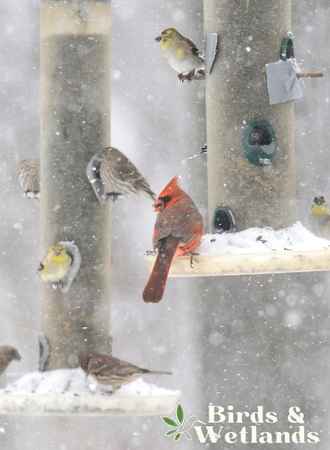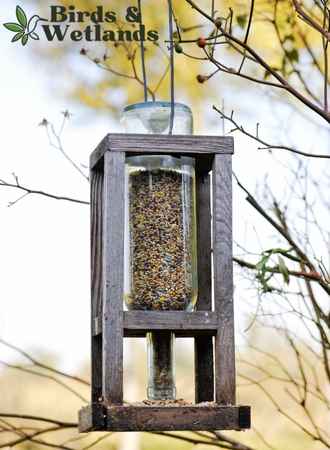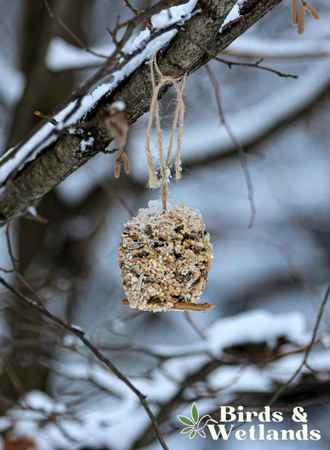As winter approaches, many birds struggle to find enough food to survive the cold months. With snow covering the ground and natural food sources dwindling, it can be challenging for our feathered friends to find the nutrition they need. That’s where bird feeders come in!
Commercial bird feeders are readily available and can be a great solution, but making your own winter bird feeder can be an enjoyable and cost-effective way to provide food for the birds in your area.
Key Takeaways on Winter Time Bird Feeding
What are the best winter bird feeders?
As bird lovers, providing our feathered friends with a reliable food source through home made bird feeders is a great way to support them through the winter months. Here are some of the best winter bird feeders available and what features to look for when selecting one.
Tube Feeders
Tube feeders are a popular choice for winter bird feeding. They’re easy to fill and maintain and can hold a large amount of seed. They’re also designed to keep the seed dry and protected from the elements. The tube-shaped design also prevents squirrels and rodents from stealing the bird’s food.

Hopper Feeders
Hopper feeders are another great option for winter bird feeding. They have a large capacity and are designed to protect the seed from snow and moisture. They typically have a roof or cover to protect the food, and some models come with a built-in tray to catch any spilled seed.
Hopper feeders can attract various birds, including larger species like cardinals and jays.
Suet Feeders
A suet mixture is a popular choice for winter bird feeding because it offers birds a high-energy food source to help keep them warm.
Homemade suet is a type of fat that birds can easily digest, and it’s especially important for birds that don’t eat seeds, such as woodpeckers and nuthatches.
Suet feeders can come in a variety of designs, from cages to blocks, and can be hung from a tree or placed on a flat surface.

Platform Feeders
Platform feeders are a simple and versatile option for winter bird feeding. They consist of a flat surface where seeds are placed. These feeders can be mounted on a pole or hung from a tree, and they’re typically designed to allow water to drain away, keeping the seed dry.
When choosing a winter bird feeder, there are a few key factors to consider.
First, you’ll want to select a durable and weather-resistant feeder, as it will need to withstand snow, ice, and freezing temperatures. Look for feeders made from sturdy materials like metal or high-quality plastic, and make sure they’re easy to clean and maintain.
You’ll also want to consider the size of the feeder and the type of birds you’re hoping to attract. Some feeders are designed to attract specific species, so choosing the right one for your needs is important.
How to make DIY bird feeder for winter
Creating homemade bird feeders can be a fun and rewarding project, especially during the winter when birds can use a little extra help finding food.
Here are some ideas for DIY winter bird feeders:
- Pine Cone Bird Feeder: This is a classic bird feeder that’s easy to make. You’ll need a pine cone, some peanut butter, bird seed, and string. First, tie a string around the top of the pine cone. Then, spread peanut butter all over the pine cone and roll it in bird seed. Hang the pine cone from a tree branch.
- Orange Cup Bird Feeder: Cut an orange in half and scoop out the inside. Poke four holes near the top of the orange peel and thread two strings through the holes to make a hanger. Fill the orange peel cup with bird seed and hang it from a branch.
- Toilet Paper Roll Feeder: This is a great way to reuse toilet paper rolls. Simply coat the outside of the roll with peanut butter and roll it in bird seed. Slip it onto a branch.
- Milk Carton Feeder: Clean and dry an empty milk carton. Cut out large windows on each side, leaving enough space at the bottom to hold bird seed. Paint the outside of the carton (optional). Make a hole in the top, thread a string through, and hang the carton from a branch.
- Suet Cake: Suet is a high-energy food that birds love in winter. To make a suet cake, you’ll need a pound of suet (which you can get from a butcher), 1 cup of birdseed, 1 cup of peanut butter, and 1 cup of cornmeal. Melt the suet over low heat until it’s liquid, then mix in the birdseed, peanut butter, and cornmeal. Pour the mixture into a mold (a small baking pan or a plastic container will work), and let it cool and harden. Once it’s hard, you can hang it in a suet cage or net bag.
- Bottle Bird Feeder: Use a clean, dry plastic bottle. Make two holes opposite each other about a third of the way up the bottle. Insert a wooden spoon through the holes, making sure the spoon end is inside the bottle. Add seeds through the bottle’s opening. Birds can perch on the spoon handle and access seeds through the spoon’s mouth. Make a couple more holes for hanging the feeder.
Making a DIY bottle bird feeder and hanging it on trees for cold winter months is a fun and easy project with easy crasts that can nourish birds during the cold months when foods are scarce. With just a few materials and a little bit of time, you can create a simple feeder that will attract a variety of birds to your backyard.
Here’s how to make a DIY bird feeder for winter:
Materials:
- A plastic bottle or container with a lid (such as a milk jug, wine bottle, mason jar or yogurt container)
- Scissors or a craft knife
- String or twine
- Birdseed
Instructions:
- Choose a container for your feeder. A plastic milk jug, soda bottle, or yogurt container works well. Make sure the container has a lid to keep the birdseed dry and fresh.
- Clean the container thoroughly, removing any labels or residue. Make sure the container is completely dry before proceeding.
- Cut a hole in the center of the container, leaving a few inches of space around the edges. The hole should be large enough for birds to access the birdseed, but small enough to prevent squirrels and larger animals from getting to it.
- Cut two small holes near the top of the container, on opposite sides or make a center hole. Thread a piece of string or twine (avoid using fishing line) through these holes, tying a knot on each end to create a loop. This will be used to hang the feeder from a tree or hook.
- Using a hot glue gun, you can make the base stable by adding wicker paper plate holder.
- Fill the container with birdseed, making sure not to overfill it. Leave enough space for the birds to perch on the edges and access the seed.
- Screw the lid onto the container, making sure it is secure and tight.
- Hang the feeder from a tree or hook, making sure it is at a height that is easily accessible to birds.
That’s it! Your DIY winter bird feeder is now ready. These DIY feeders are attractive hanging from plant hooks or a tree branch..
Happy Birding

When it comes to feed birds from your feeder, remember to choose the best bird food for the bird species in your area. Birds enjoy black oil sunflower seed, and these can be vital for winter birds. For winter birds – see our guide to the best food for winter time.
Black Oil Sunflower Seed
- High Nutrient Content: The Blue Seal Premium Black Oil Sunflower Wild Bird Seed is high in fat and protein, providing essential nutrients to wild birds especially during harsh winter months.
- Attracts Diverse Species: The seeds are known to attract a wide variety of wild birds, such as Northern Cardinals, Tufted Titmice, Mourning Doves, and Evening Grosbeaks, thereby enhancing your bird-watching experience.
- Increased Survival Rates: The presence of these bird seeds in your feeder can increase bird survival rates by up to 38%, contributing to the conservation of local bird populations.
- Promotes Overall Health: Offering a consistent and reliable source of feed like this can lead to less stress and greater overall health in the bird population visiting your garden.
Does bird seed mix spoil in winter?
Backyard birds eat a variety of foods, and bird seed is a popular food option for them, especially during the winter when natural food sources are scarce. However, many bird enthusiasts are concerned about whether bird seed will spoil in winter.
The short answer is that it depends on the type of birdseed mix and how it is stored. Some types of birdseed can spoil quickly if they are exposed to moisture or air, while others can last for several months without spoiling.
Most bird seed mixes contain a combination of seeds such as sunflower seeds, millet, and corn. These seeds are a good energy source for birds and are typically not harmful if they spoil. However, spoiled bird seed can attract pests such as rodents, insects, and mold, which can be a health hazard for both birds and humans.
The best way to prevent birdseed from spoiling in winter is to store it in a dry and cool place, such as a garage or basement. Avoid storing birdseed in areas that are damp or humid, as this can cause the seeds to spoil more quickly. If you are storing birdseed outside, make sure to use a bird feeder that is designed to protect the seed from moisture and pests.
It’s also important to check the expiration date on the birdseed before purchasing it. Most bird seed mixes will have a “best by” date printed on the packaging, indicating the date the seeds are at their freshest.
If you are unsure about the freshness of your bird seed, you can also perform a quick visual and smell test. Fresh birdseed should have a pleasant aroma and look dry and clean, while spoiled birdseed may have a musty or moldy smell and appear clumpy or wet.
Additional Tips
- With just a few simple items, such as a tennis ball, some twine, and an angel food cake pan, it is possible to easily and swiftly transform the pan into a bird feeder.
- You can spread salt-free peanut butter on a pine cone, roll it until it is covered in seeds, put it on a tray on top of a baking sheet.
- Most birds will not eat seed mixes with plenty of filler so make sure you get them good quality seeds.
- Some birds love to eat fruits so you can include dried fruit and apple slices to your feeder. If you plan on feeding birds raisins, cut them then soak in warm water.




